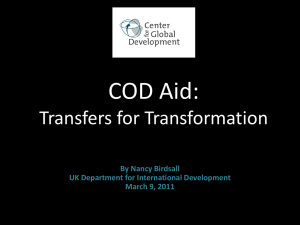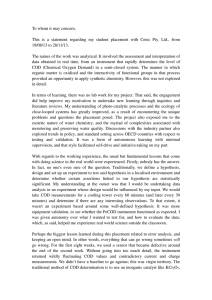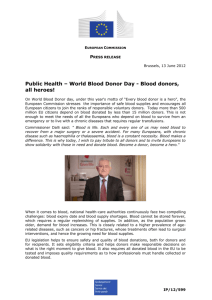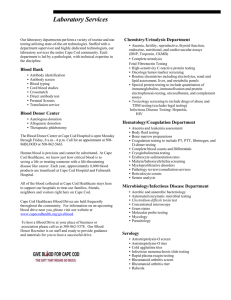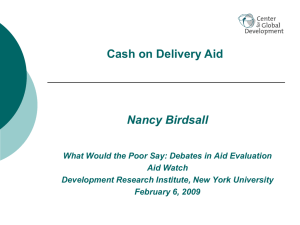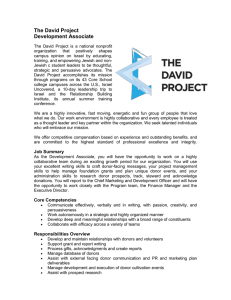Cash on Delivery Aid: Exploration of Feasibility in Ethiopia Nancy Birdsall
advertisement
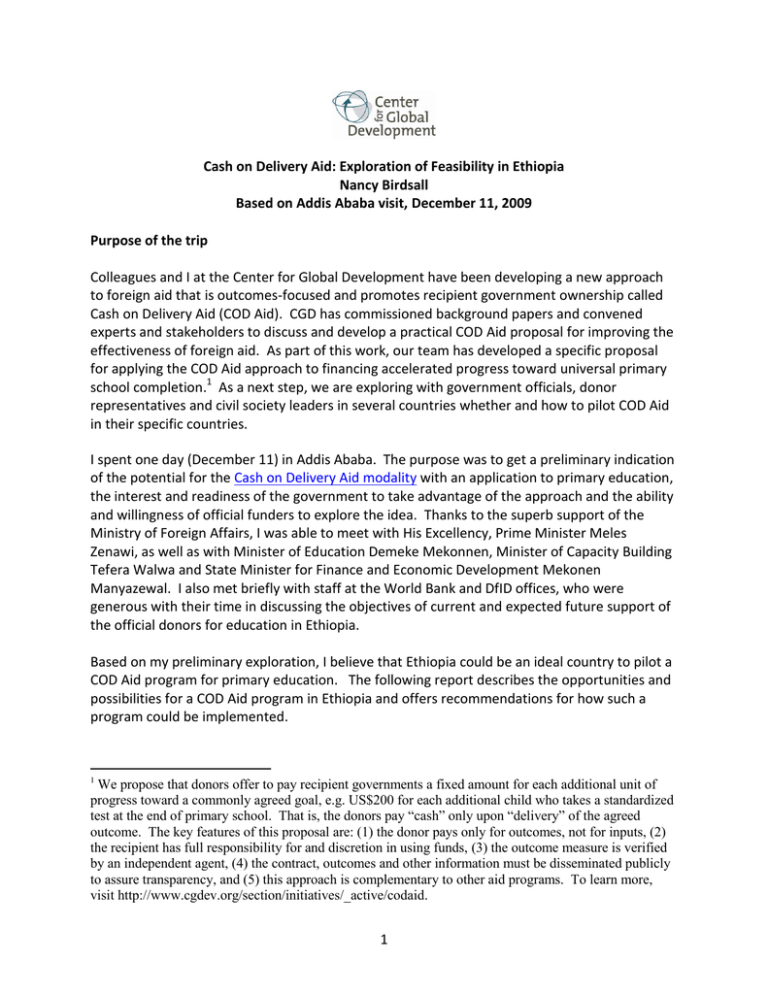
Cash on Delivery Aid: Exploration of Feasibility in Ethiopia Nancy Birdsall Based on Addis Ababa visit, December 11, 2009 Purpose of the trip Colleagues and I at the Center for Global Development have been developing a new approach to foreign aid that is outcomes-focused and promotes recipient government ownership called Cash on Delivery Aid (COD Aid). CGD has commissioned background papers and convened experts and stakeholders to discuss and develop a practical COD Aid proposal for improving the effectiveness of foreign aid. As part of this work, our team has developed a specific proposal for applying the COD Aid approach to financing accelerated progress toward universal primary school completion.1 As a next step, we are exploring with government officials, donor representatives and civil society leaders in several countries whether and how to pilot COD Aid in their specific countries. I spent one day (December 11) in Addis Ababa. The purpose was to get a preliminary indication of the potential for the Cash on Delivery Aid modality with an application to primary education, the interest and readiness of the government to take advantage of the approach and the ability and willingness of official funders to explore the idea. Thanks to the superb support of the Ministry of Foreign Affairs, I was able to meet with His Excellency, Prime Minister Meles Zenawi, as well as with Minister of Education Demeke Mekonnen, Minister of Capacity Building Tefera Walwa and State Minister for Finance and Economic Development Mekonen Manyazewal. I also met briefly with staff at the World Bank and DfID offices, who were generous with their time in discussing the objectives of current and expected future support of the official donors for education in Ethiopia. Based on my preliminary exploration, I believe that Ethiopia could be an ideal country to pilot a COD Aid program for primary education. The following report describes the opportunities and possibilities for a COD Aid program in Ethiopia and offers recommendations for how such a program could be implemented. 1 We propose that donors offer to pay recipient governments a fixed amount for each additional unit of progress toward a commonly agreed goal, e.g. US$200 for each additional child who takes a standardized test at the end of primary school. That is, the donors pay “cash” only upon “delivery” of the agreed outcome. The key features of this proposal are: (1) the donor pays only for outcomes, not for inputs, (2) the recipient has full responsibility for and discretion in using funds, (3) the outcome measure is verified by an independent agent, (4) the contract, outcomes and other information must be disseminated publicly to assure transparency, and (5) this approach is complementary to other aid programs. To learn more, visit http://www.cgdev.org/section/initiatives/_active/codaid. 1 Potential for COD Aid for education – using our proposed indicator of assessed completers The potential is good for an initial COD program – as explained below not nationwide but in one or two regions. Why good? First, compared to other countries at low per capita income, Ethiopia has a reasonably effective public administration and is in the middle of a five-year education sector development program focused on primary education. Government officials at high levels complain of the high transactions costs of working with donors, but are clear that they are fully responsible for their own policies and institutional commitments, including in the education sector. Second, primary education has been and is a government priority, with impressive progress in the last decade, and is a major area of donor support. In the $1 billion a year Protection of Basic Services (PBS) program, donor funds complement government funds and are passed to the regions in the form of block grants to cover health, education and other basic services. Meanwhile, a new national program called the General Education Quality Improvement Program (GEQIP) is getting off the ground, and a group of donors including the World Bank, the Education for All – Fast Track Initiative (FTI), the UK Department for International Development (DfID), and the Netherlands are preparing to finance together its costs in the amount of about or up to $100 million a year. Indicators are being agreed for GEQIP that are meant to complement, with a greater emphasis on quality, the already agreed indicators under PBS and the primary part of the education sector program. Third, the government and donors have broad agreement in place on a set of input, output and outcome indicators for primary education, which are being regularly monitored under the PBS and as part of the primary education sector program. Some advantages of an additional COD Aid component Despite good past progress and substantial government and donor financing, there is plenty of room for faster progress. The primary completion rate (8 years) was only 42% in 2006, and girls are far more likely to drop out early, so their completion rate is only about 33%. There are at present no good measures of learning, or even of the annual number of what we would call “assessed completers”, i.e. the number of students who took a test of their knowledge and skills upon completing primary school. Though there is never enough financing for key inputs, my impression is that the amount of financing implied by current and planned annual external and domestic spending in primary education would in principle allow for sensible expansion and quality gains. An additional bonus-like payment tied to assessed completers would generate incentives for greater efficiency in the deployment of the existing resources, for new pilot programs within the regions, for a cross-ministry campaign under the leadership of the prime minister and for a greater emphasis on learning and quality than has been the case. 2 There is a big and well-recognized need for an emphasis on assessment of learning, and the ingredients are in place to jumpstart that process. Despite the Government of Ethiopia (GOE)donor agreements on reporting, the capacity in the central Ministry for management and implementation of the Education Management Information System (EMIS) and training in EMIS management at the regional level is limited, and the regions do not all systematically report what data they may be collecting, even on enrollment. Assessment of learning at the completion of primary school is done by the regions; my understanding is that a full assessment is done only every four years, and on a sample basis only. USAID is initiating support for a major ($300 million) program of assessment of learning at grades 4 and 8 (Adaptable Program Learning), complementing the planned GEQIP funding of textbooks, teacher training and school improvement grants over the next four years. The central Ministry is responsible for assessments at grades 10 (for advancement to preparatory secondary school) and 12 (for university admissions). There is probably a considerable margin for harnessing civil society groups, at least in Addis and other large cities, to focus on accountability of regional and district (woreda) governments for schooling that is adequate. I did not learn much about the status and effectiveness of civil society, but my impression is that there is room for greater engagement in such important local issues. Issues for the traditional donors My impression is that donor staff working in education feel considerable pressure to finalize the “program” of GEQIP financing (perhaps for approval in the first half of 2010), including incorporating FTI funds that require a separate proposal, and would see incorporating a COD component as an additional headache. Though in Ethiopia programs once “owned” by government do move, in the PBS program there have been collaboration problems at the central and regional level between education and finance staff, presumably because capacity at the technical level is limited. So the process of agreeing on a large overall program like GEQIP has been protracted. On the other hand, the donors have made considerable progress in developing agreed indicators at various levels of progress with the government, including at the regional level, and the indicators include (especially given the GEQIP focus on quality) the outcomes of primary completion and of learning (though how these will be measured was not clear to me, and they are not receiving any particular priority compared to multiple other input and output measures). Next steps? A five-year COD Aid contract would best be set up in just one or a few regions, given Ethiopia’s size. This makes more sense than a nation-wide contract anyway since it is the regions that have the major responsibility for managing schools. The central government would have to 3 support the idea of annual and universal testing of completers in the one or two regions, presumably with the cooperation of the regions, as an investment over the long run in acquiring useful information about what is working to increase completion rates and learning nationwide. In a single region such as Tigray, where perhaps 50,000 students might have finished primary school last year, a very crude estimate of annual COD disbursements would be $3.5 million (averaged over a five year contract). To start the process the government would need to communicate to CGD or to at least one funder its interest in exploring the nature of the COD model contract we have designed, understanding its obligations and responsibilities under that contract and proposing its own version of it. This would not be a complicated process; it can in principle be accomplished in a single day. A reasonable next step would be for key people in government to review the model contract we have available, to assess from their point of view whether it is of interest. Independent of that possible interest, we strongly recommend that the government and/or the donors could discuss incorporating into the GEQIP as a key indicator “assessed completers”, with a plan for how and where to focus a testing program. 4

